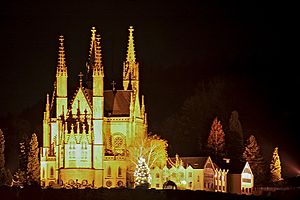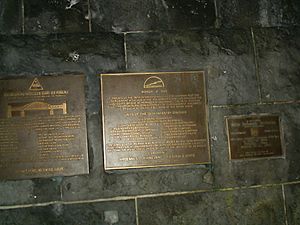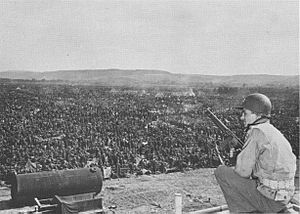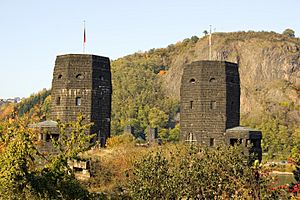Remagen facts for kids
Quick facts for kids
Remagen
|
||
|---|---|---|

Apollinariskirche
|
||
|
||
| Country | Germany | |
| State | Rhineland-Palatinate | |
| District | Ahrweiler | |
| Elevation | 60 m (200 ft) | |
| Population
(2022-12-31)
|
||
| • Total | 17,426 | |
| Time zone | CET/CEST (UTC+1/+2) | |
| Postal codes |
53424
|
|
| Dialling codes | 02642, 02228 | |
| Vehicle registration | AW | |
| Website | www.remagen.de | |
Remagen (German pronunciation: [ˈʁeːmaːɡn̩]) is a town in Germany. It is located in the state of Rhineland-Palatinate, in the Ahrweiler area. Remagen is about an hour's drive from Cologne. It is just south of Bonn, which used to be the capital of West Germany.
The town sits on the left (western) bank of the Rhine river. A ferry crosses the Rhine from Remagen every 10–15 minutes in the summer. Remagen has many interesting and well-kept buildings. These include churches, castles, and monuments. It also has a large area just for walking, with lots of shops.
Overlooking the west bank of the Rhine, just north of the town center, is the Apollinariskirche. This church has a viewing deck. It is usually only open to church members on Sundays. You can reach the church by walking up a dirt path. This path has monuments showing the fourteen Stations of the Cross. The church grounds also have an outdoor crypt and an abbey. Further down the river, you can see one of the many castles along the Rhine. It sits even higher than the Apollinariskirche.
Contents
History of Remagen
The Roman Empire built a border fort called Rigomagus (or Ricomagus) here. This fort was west of the Rhine river. It was about 12 miles north of where the first bridge across the Rhine was ever built. This first bridge was made to fight the river's strong current. It was built on slanted wooden timbers driven into the riverbed.
Julius Caesar's troops spent almost three weeks on the east side of the river. Then, they crossed back and destroyed the bridge. This was to stop German raiders from using it. A second bridge was also destroyed by its builders once they were done with it.
The fort was one of many built by Drusus. He was a commander of the Roman army along the Rhine. Other Roman buildings survived for centuries. These include a gateway. Remagen became a popular place for tourists, especially for people who love history. Remagen is even shown on the 4th century Peutinger Map, an old Roman road map.
A local story says that a ship carrying important relics from Milan to Cologne stopped in the river in 1164. It could not move, even with the strong current. Then, it mysteriously moved towards the shore. The remains of Saint Apollinaris were taken off the ship. After that, the ship could sail again. These remains were placed in a chapel. This chapel had been part of the Roman fort. It became the basis for a church named after him. This church was rebuilt many times over the years.
The Famous Bridge at Remagen
The Ludendorff Bridge was first built during World War I. Its purpose was to move soldiers and supplies west over the Rhine. This helped to support the Western Front. Karl Wiener, an architect from Mannheim, designed the bridge. It was 325 metres (1,066 ft) long. It was 14.8 metres (49 ft) above the normal water level of the Rhine. Its highest point was 29.25 metres (96.0 ft).
The bridge was designed to be defended by soldiers. It had towers on each river bank with small openings for machine guns. The bridge had two railway tracks and a path for people to walk. During World War II, one track was covered with planks. This allowed cars and trucks to use the bridge.
How the Bridge Was Captured
During Operation Lumberjack, on March 7, 1945, American soldiers reached the Ludendorff Bridge. This was in the final weeks of World War II. They were very surprised to see that the railroad bridge was still standing. German defenders had failed to blow it up. This made it the only one of 22 road and railroad bridges over the Rhine that was still standing.
U.S. forces were able to capture the bridge. This unexpected chance to cross the Rhine was very important. The Rhine was Germany's last major natural barrier. The capture of the bridge caused the Allied commander, Dwight D. Eisenhower, to change his plans. It may have even shortened the war in Europe.
Being able to quickly set up a bridgehead (a secure area) on the eastern side of the Rhine was key. It allowed U.S. forces to move into Germany's industrial area, the Ruhr, faster than planned. The Allies were able to get six army divisions across the bridge. However, the bridge collapsed on March 17, 1945. This was ten days after it was captured. The collapse killed 18 U.S. Army Engineers. Another report says 28 U.S. engineers died and 93 were hurt. By then, a floating pontoon bridge had been built across the river. The main bridge was also closed for repairs when it collapsed.
Many books and articles have been written about the battle for the bridge. A well-known book is The Bridge at Remagen by Ken Hechler, published in 1957. In 1968, David L. Wolper made an American movie called The Bridge at Remagen. The film shows historical events, but most of the story is made up.
The Bridge Memorial
Hans Peter Kürten, who was the Mayor of Remagen in 1968, wanted to build a memorial. It took seven years just to talk with the German Federal Railways. Finally, the city could buy the old railway land. The mayor tried to get government officials interested in keeping the bridge towers and building a Peace Memorial. But no one seemed interested.
In the summer of 1976, the bridge support pillars in the river had to be removed. The mayor had the stones placed on the Remagen river bank. He planned to sell small pieces of these bridge stones. They would be put in clear plastic with a certificate to prove they were real.
On March 7, 1978, he announced his idea to the public. It was a huge success! He made over 100,000 DM (about 50,000 EUR) in sales profits.
No new bridge has been built across the Rhine here since then. This is mainly because people in Remagen and nearby areas do not want one. They say a new bridge would ruin the beautiful view.
Prisoner Camps
In 1945, the U.S. Army built several large camps on the west bank of the Rhine. These were called Rheinwiesenlager. One was near Remagen. The Allies used these camps to hold captured German soldiers. It is thought that several thousand prisoners died in these camps. 1,212 of them are now buried in the Bad Bodendorf Cemetery.
Geography of Remagen
How Remagen is Divided
Remagen is split into six main areas called districts (Ortsbezirk). These districts contain eight smaller places called localities (Ortsteile).
| District (Ortsbezirk) | Locality (Ortsteil) | residents |
|---|---|---|
| Remagen | Remagen | 7.611 |
| Kripp | Kripp | 3.756 |
| Oberwinter | Bandorf, Oberwinter, Rolandseck | 3.712 |
| Oedingen | Oedingen | 1.034 |
| Rolandswerth | Rolandswerth | 588 |
| Unkelbach | Unkelbach | 1.143 |
| Total city | 17.844 |
residents (excluding secondary residences, June 30, 2020
The district of Kripp is also part of the larger Remagen district.
Places to Visit in Remagen
The Apollinariskirche Church
The Apollinaris Church was built between 1839 and 1842. It stands on the site of an older medieval church called St. Martin. The paintings inside this neo-Gothic church were done by artists known as the "Nazarenes." There are three sets of paintings. They show the life of Jesus, the life of Mary, and the story of Saint Apollinaris. He was a famous Bishop of Ravenna.
In the crypt (an underground room) of the church, there is a silver statue of the saint. This statue is lifted from its sarcophagus (stone coffin) every year during the pilgrimage time in late July. From the statue of Saint Francis of Assisi on top of the church, you can see a beautiful view of Remagen and the lovely Lower Rhine Valley.
Peace Museum "Remagen Bridge"
This museum is located inside the towers of the famous bridge. The bridge was built between 1916 and 1918. The museum opened in 1980. It tells the story of the bridge. It also shares information about the U.S. prisoner of war camp known as the Golden Mile. This camp was on the flat land with the same name.
Arp Museum at Bahnhof Rolandseck
The old railway station at Rolandseck is about 5 km north of Remagen. It now holds a museum dedicated to the art of Hans Arp. This 19th-century railway station is a great example of early German railway building. It became a place for all kinds of arts in the 19th century.
Famous musicians like Johannes Brahms, Clara Schumann, and Franz Liszt performed concerts there. George Bernard Shaw even put on his plays there. The young poet Guillaume Apollinaire fell in love there. After World War II, the building was neglected and almost torn down. But in 1964, a Bonn art dealer named Johannes Wasmuth brought it back to life. Many famous people have appeared there. These include musicians like Martha Argerich and Yehudi Menuhin. Artists like Oskar Kokoschka and Günther Uecker also visited. Performers like Marcel Marceau have also been there.
Transportation in Remagen
Remagen station is on two railway lines: the Left Rhine line and the Ahr Valley Railway. Trains like the InterCity, Regional-Express (the Rhein-Express), and Regionalbahn services (MittelrheinBahn) stop here every hour. These trains travel between Cologne and Koblenz. The station also has Rhein-Ahr-Bahn services. These go on the Ahr Valley Railway to Ahrbrück every hour.
Famous People from Remagen
- Peter Maech (1512–1552), the 23rd abbot of Maria Laach
- Henriette Jügel (1778-1850), a painter
- Emilie Storck (born 1827 in Remagen), who was the wife of Friedrich Wilhelm Raiffeisen
- Baptist Schneider (1867–1946), a photographer in Remagen
- Rudolf Caracciola (born 1901 in Remagen; died 1959 in Kassel), a racing driver
- Roland Ries (born 1930 in Remagen), a church leader and president of the German hospital association
- Klaus Barth (born 1935 in Remagen), a retired ambassador
- Rudi Altig (1937-2016), a cyclist
- Jean Lessenich (born 1942 in Remagen), a tracer and author
- Bernhard Philipp (born 1948 in Remagen), a Capuchin friar, theologian, and artist
- Thomas Gottschalk (born 1950), a German TV presenter, lived in Marienfels Castle from 2006 to 2012
- Franz Surges (1958-2015), a composer and church musician
- Matthias Buchholz (born 1967), a cook who received a star in the Guide Michelin
See also
 In Spanish: Remagen para niños
In Spanish: Remagen para niños





